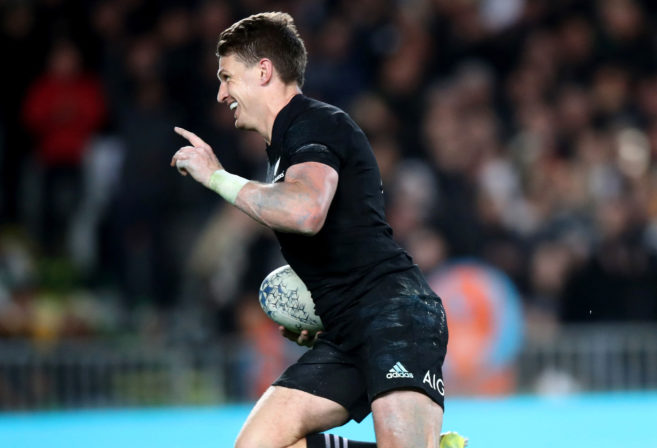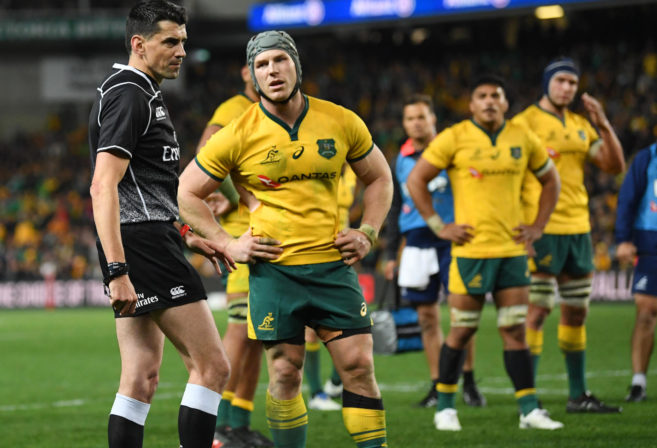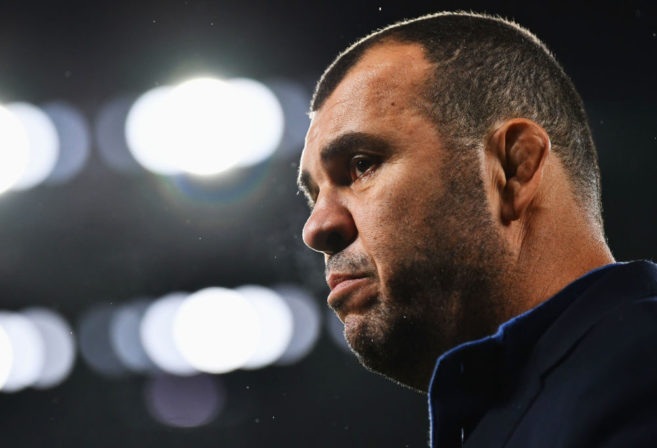It’s common to reflect back on momentous events and recall exactly where you were and what you were doing when it happened.
The deaths of Elvis Presley and Princess Diana are often cited, Australia’s 1983 America’s Cup win and the 2001 attack on New York’s Twin Towers are others.
As a rugby playing student I can still picture the exact seat I was sitting in, in a modest little TV room in Stuart House, Carrington Hall, Dunedin, when, in 1978, Greg Cornelson scored four tries in the Wallabies’ shock 30-16 defeat of the All Blacks at Eden Park.
It has been said Cornelsen just happened to be ‘in the right place at the right time’, although getting lucky four times would suggest that there was something other than just luck involved.
Forty years on, and 50,000 people will be able to say that they were at Eden Park the night Beauden Barrett scored four tries in a Bledisloe Cup match. They will know also none of them were down to luck, but were instead a result of the vision and pace of an extraordinary rugby player.
It could have been more. With three tries already under his belt, Barrett celebrated a fourth in the 66th minute – that is until television match official Marius Jonker detected a slight knock-on from energizer bunny Ardie Savea in the lead-up.
As Jonker and referee Wayne Barnes worked through the process, what stood out was Barrett’s demeanour – laughing and joking on the sideline – as if he knew, and everyone else knew, that it wasn’t a problem, there was another try coming regardless.
Which of course it did. Only three minutes later, Barrett was on the end of yet another sweeping, long-range run and support effort by the All Blacks.
Among the many highlights, two moments from Barrett stood out. One was the first play of the game when, after Aaron Smith had his clearing kick charged down, Barrett scurried back to collect the ball, hemmed in near the corner flag.

(Photo by Phil Walter/Getty Images)
Under pressure and with no space to work in, trapped onto his left foot, Barrett drilled the ball 65m up the touchline, effecting a far better exit than the All Blacks could have hoped for. In doing so, he set the tone for what was to follow.
Another special moment was Barrett’s third try, finding space in the defensive line around Adam Coleman before jetting into the backfield and making Will Genia and Jack Maddocks – both of whom who are no slouches – look like they were standing still.
It was one of many examples of what sets the All Blacks apart from the Wallabies – not just Barrett’s extreme pace – but the relentless manner in which their forward pods probed the Wallabies’ midfield defence, working them from side-to-side, asking them to make tackle after tackle and reset every time. They patiently waited until a mismatch like Barrett against Coleman was engineered, or the Wallabies fractionally lost their spacing, as Tatafu Polota-Nau did for Liam Squire’s try just after halftime.
Social media was quick off the mark to punish the Wallabies with Barrett jokes, like how, if he hadn’t played the Wallabies would have won 12-10, and how, with his bonus point for scoring four tries, Barrett sits one point above the Wallabies on The Rugby Championships ladder.
In light of this performance – and some of his work in Sydney last week – Barrett has emphatically driven the Richie Mo’unga contender club underground to, frankly, where they should always have been. A few non-impactful games for a scratchy Hurricanes’ team means nothing when he was always going to thrive coming back into the All Blacks environment.
Mo’unga, for his trouble, also took time to share a joke on the sideline with Barrett, no doubt watching and learning, wondering how he might be able to extract that yard of killer pace to add to his own undoubted talents. He will, in due course, get his turn, but for now, the 2016 and 2017 World Rugby Player of the Year, looks well on target to join Richie McCaw and Dan Carter as a three-time winner.
Brodie Retallick is another re-energized by his return to Test rugby, dominant all around the park and just like last week sparked another long distance try with a dominant, almost bullying turnover.
A mention too for the quality of Ben Smith, taking advantage of the absence of Israel Folau, commanding the air space and consistently making good decisions with the ball, none better than on his weaving run in the lead-up to Barrett’s second try.
As for the Wallabies inability to cope defensively on the turnover, there were a couple of factors at work. One was the ability of the All Blacks to sniff the kill and move the ball with urgency – watch how TJ Perenara instinctively steps and shifts play to the weak point (Damien McKenzie versus a forward), to spark Barrett’s final try.
The Wallabies also compounded their woes by losing defensive shape, with players taking it upon themselves to rush up – understandably eager to shut down any counter-attack with a spot-tackle, but in doing so, actually creating more space in behind the defensive line for the All Blacks to work with.
A rushing defence can be effective at creating pressure early in the phase count, when the defenders are stationed in familiar positions and before fatigue has set in. But once the defence has been prodded and probed, moved around and stressed over multiple phases, or if the ball is turned over unexpectedly, it’s more important for defenders to maintain contact with each other and think about how they can collectively fill the secondary and backfield – even if that means being more passive.
The All Blacks entered the match with a clear strategy to target David Pocock at the breakdown, and it was testament to his durability and character that he was still standing after a Herculean-like 80 minutes.
Pocock also received praise after the match for a sporting gesture, showing early concern for Liam Squire, however, this one seemed problematic and potentially more about gamesmanship than anything else.

(AAP Image/David Moir)
Replays showed that Pocock made heavy contact with Squire’s shoulder, not his head, and Squire indicated the same to referee Wayne Barnes. It is not the Wallabies’ business to be rushing to the referee to ask that opposition players be taken off for a HIA.
Nor, it must be said, should the referee be acting on any such advice. Barnes has two Assistant Referees and a TMO to alert him to any potential concussion issue, and further, in today’s rugby, it would be almost unheard of for the training and medical staff of any side to allow a player to stay on the field if they felt there was a need for a HIA.
In another losing effort it is hard to find Wallabies positives, although Bernard Foley did well to break the line and put Reece Hodge away for their second try, and his covering effort to deny what looked like a certain Jordie Barrett try was outstanding.
There were encouraging signs from Lukhan Tui, who looks more like a Test player by the week and from Dane Haylett-Petty who relished finally getting an opportunity at fullback, his preferred position.
As expected, the Wallabies made improvements to their set-piece to the extent that bringing on a scrum battle near the All Blacks’ line – and winning it – provided a platform for Will Genia’s first-half try.
But at 40-12, sections of the press predictably zeroed in afterwards on coach Michael Cheika, questioning his longevity in the position. While his win-loss record makes for uncomfortable reading, it’s worth noting almost all of the criticism has failed to throw up a single, realistic alternative.

(Photo by Dan Mullan/Getty Images)
The underlying issues in Australian rugby’s playing depth and culture which were evident last year, last month and last week still remain, and will likely remain until the coming generation of players and coaches edge their way through the system, learning how to win more regularly against New Zealand’s Super Rugby sides.
If there was any expectation of a ‘Cornelsen-like’ upset victory in Auckland then this was misplaced. It was noticeable afterwards how Steve Hansen didn’t resort to false modesty when he said, “It’s a pretty special team down in that changing room. I don’t think it should put a coach under pressure just losing to us.”
It is a common cry from frustrated fans that today’s Wallabies wouldn’t hold a candle to the 1984 ‘grand slam’ side, or Rod McQueen’s turn of the century team. It is of course very difficult to compare players and teams across eras, so who knows how a matchup between those sides and today’s sides would go?
But one thing I promise you for certain is the All Blacks of 1984 and 1999-2003 would be annihilated by today’s All Blacks – a perspective I think worthy of consideration for angry fans.
The women’s Test match also carried last week’s outcome forward, the Black Ferns this time winning 45-17 over the Wallaroos.
Women’s rugby is advancing and will continue to do so as these leading players get more experience and benefit from more coaching and improved conditioning. But it is also interesting to highlight a key deficiency and draw a parallel with what has happened in the AFLW competition.
One of the biggest differences between men’s and women’s football is in kicking distance and accuracy. Without the ability for players to kick the ball 50m plus, the game loses an important dimension.
With nothing be gained from kicking the ball 25m and giving up possession, coaches instead encourage their sides to retain possession and work the ball up-field, pick and go-style.
So women’s rugby becomes similar to AFLW in the sense that shorter kicking distances lead to increased amount of unsightly congestion around the ball.

(Photo by Hannah Peters/Getty Images)
Women’s sevens has shown us that these players have excellent passing and running skills – but the XV game needs to find a way to generate more open play – such as the try superbly finished by Black Ferns winger Renee Wickliffe – if it’s to win greater support from fans.
There was certainly no shortage of sparkling open play from the Pumas in Mendoza, stunning the Springboks 32-19 in what was their best performance since their quarter-final win against Ireland in the 2015 World Cup.
It seems apparent that coach Mario Ledesma has been able to rid the players of their ‘victim mentality.’ His side are playing with supreme confidence and skill in the backs, winning the collision battle up front, and competing aggressively against the Springbok’s lineout.
This loss is a setback for new ‘Boks coach Rassie Erasmus, but it’s still early days as he tries to determine his best combinations. His next task will be to restore some sting and venom into the defensive effort, which was very un-Springbok like.
Although the All Blacks have skipped away to their customary early lead in the Rugby Championship standings, the remaining three sides appear to be evenly matched.
If Australian fans can convince themselves over the next couple of weeks that the sky isn’t actually falling in, they can look forward to some very exciting rugby, starting again in a fortnight’s time in Brisbane.

































































































